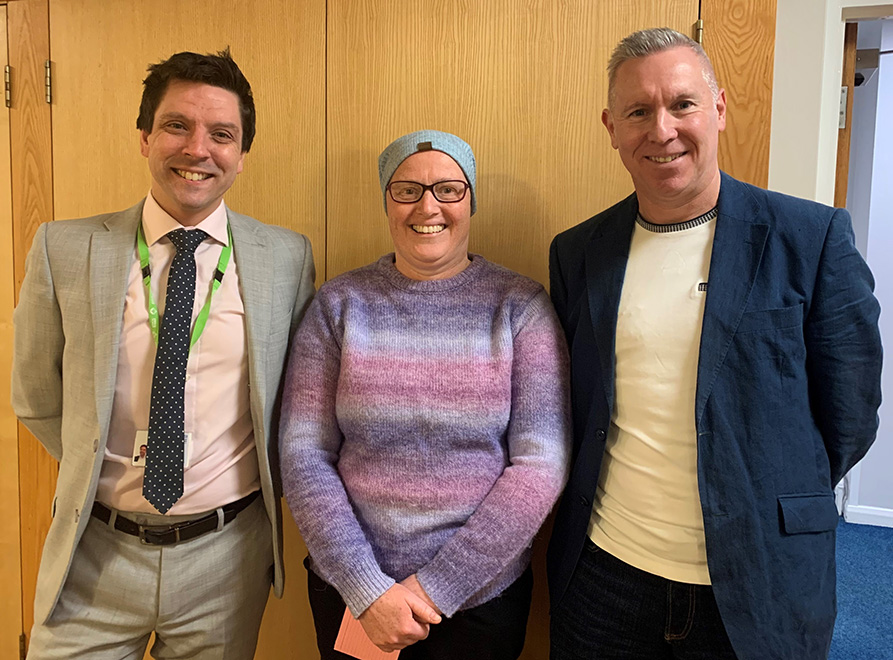From Board to Ward – March 2024

So, February was eventful, with our longstanding Chief Executive Ann James announcing she is stepping down later this month, we welcomed the Medical Director from NHS England, Professor Stephen Powis and others to Plymouth to see the innovation we’re leading for stroke patients and UHP helped in the Major Incident response to an unexploded WW2 bomb in Keyham. At today’s Board meeting, Deputy Chief Executive Sarah Brampton thanked staff for stepping up to the Major Incident response and their work to make sure we were prepared to receive casualties if needed and praised the “exceptional” response of Livewell Southwest colleagues in supporting the people of Keyham.
Every month our Board leaders meet in public to assess how we’re doing for the patients and communities we serve, how we’re doing for our staff, our achievements, our challenges with a big focus on what we’re doing to address them and what our plans are for the future. Who are our Board?
Here we share three key highlights from each Board meeting in a bid to shine a light on key progress, decisions and share in an open and transparent way some key developments.
Highlights from March Board:

Our Transport Strategy
Did you know there are 2,842 car parking spaces at Derriford Hospital and that the hospital hosts the second busiest bus terminal in Plymouth?
| Public | Staff | Blue Badge | Dementia | Contractors | Total |
|---|---|---|---|---|---|
| 916 | 1,731 | 131 | 14 | 50 | 2,842 |
Car parking at Derriford Hospital is a popular topic because demand for car parking spaces has always significantly exceeded supply at Derriford Hospital. Today the Board heard from two patients, Jonathan and Sarah who gave up their time to come along to share their experiences of parking at the hospital. Sarah spoke to the Board about being a cancer patient and the effects of chemotherapy and being unwell and finding it hard to walk from the public-only Multi-Storey Car Park to the oncology unit the other side of the site. Sarah spoke honestly about the anxiety the thought of having to park at the hospital causes. Jonathan described his experience of trying to park to give blood and how he was late for his donor appointment, as the Blood Donor Centre is also on the opposite side of the site to the multi-storey car park.

John Stephens, Director of Estates and Facilities thanked Jonathan and Sarah and said their stories are an important reminder of being able to access the hospital with minimal anxiety and recent changes had been designed to make things easier for patients but unfortunately there were some unintended consequences as we have ringfenced the multi-storey car park for patients but this is the opposite end of the site to the Oncology Unit and the Blood Donor Centre. John explained he is creating another 20 or so spaces for oncology and blood bank spaces closest to those units as well as more drop-off spaces to improve things.
John explained a new Transport Strategy is needed, especially in light of the plans for a new Urgent Treatment Centre and Fracture Clinic which is being built on part of one of the current car parks. The longstanding car parking challenge has been exacerbated recently by a decrease in the number of spaces to support the construction of critical clinical developments such as the new building which houses the Chestnut Unit and Bantham Ward.
Local and national transport and planning policies are focused on reducing parking supply and promoting sustainable travel choices at key traffic generators. There are though a number of unique factors which impact the opportunity to achieve this on an acute healthcare site with a semi-rural geography which lacks good public transport connectivity, not least of all access to public transport for many staff and patients is simply not sufficient to enable travel to Derriford by the time required. Many staff commence or end their shifts outside the operating times of regular public transport. The Board heard that a number of consultation events, with >1,000 staff involved, were undertaken in summer 2023 and the learning from this had informed the Strategy.
What’s the Strategy?
UHP has a commitment to carbon reduction, and in-line with national NHS guidelines is intending to achieve net zero carbon by 2045. Travel and modes of travel are important in this process as approximately 9% of organisational CO2 emissions arise from staff or patient car travel. The Trust has a Green Travel Plan which seeks to encourage travel by alternatives to Single Occupancy Vehicles (SOV) and has introduced a range of measures to promote public and active transport options. In particular, the introduction of free, park and ride travel to the site for staff and the ambition to provide discounts to staff using the bus network are key pillars.
Non-parking interventions
- Promotion of walking/cycling/running including access to electric bikes and a cycle to work benefit scheme
- Promotion of public transport
- Personalised travel planning
- Car sharing
Parking Interventions
Interventions for parking include separating public and staff parking and building the case for a second Multi-Storey Car Park (MSCP) on the Derriford site. There are concerns regarding the loss of car parking due to expansion and modernisation of the hospital and in the long term it is intended to avoid space loss through the creation of that additional vertical capacity (a new multi-storey car park).
| Period | Measure |
|---|---|
| January 2024 to September 2024 |
Continue existing permit management approach. Upgrading and making out NWQ to improve surface quality and maximise existing land area, such that there is no net loss of spaces from immediate planned development. Offsite parking at the Ship to provide additional 100 spaces |
| September 2024 to December 2025 |
Review staff permit criteria with the key principle of supporting staff whose work patterns do not allow them to use accessible public transport or Park and Ride option to fulfil their contractual duties and promoting equity for all staff. Continue to explore off-site car parking options. Build the case for a new MSCP on the NWQ site in preperation for any further development of the land. Implement dedicated car share capacity to further reduce SOV journeys to the Derriford site. Review space distribution to ensure public car parking capacity is sufficient for demand. Use smart technologies to improve traffic flows around the site and on the surrounding road networks. |
| January 2026 on wards |
Deliver a second MSCP, to rationalise parking and enable estate development. Seek to maintain the overall number of spaces on the Derriford campus by exploring other options for increasing car parking spaces in the event of further development on existing car parks. Continue to invest in smart technologies to improve traffic flow on and around site. |
The Board was told this Strategy ensures patients will be able to find a parking space at Derriford, and that there are sufficient Blue Badge spaces for both staff and patients on the campus. Maintaining access to the hospital for patients, and ensuring that in the long-term, overall car parking capacity on site is maintained are key priorities.
The Board discussed the possibility of introducing a valet/drop-off service and approved a new Transport Strategy to try to address this but heard that the need to continue to listen to patients, carers, visitors and staff is key.
Where are we heading? Our draft Manifesto and Clinical Strategy
Our Director of Integrated Care, Partnerships and Strategy Rachel O’Connor: presented a draft of our new UHP Manifesto. Our previous strategy “Healthier Lives: Making a Difference” comes to an end in April 2024 and we have over the past few months, in tandem with developing the clinical strategy, developed our overarching UHP strategic direction for the next 5 years to set out in our 5-year Manifesto for change. A draft summary of this is shown in the pyramid below. This is still a work in progress. As we engage with staff over the coming weeks, we will also use the opportunities to consider with them the Trust values and whether there is a need and desire for those to be refreshed/renewed.

What has driven our thinking?
The current Trust Strategy which is due to be replaced with the Manifesto identified “the aging population as a national trend, with our catchment population aged over 85 years growing ahead of the national average by approximately 10 years”.
Approximately 90%+ of our bed base is used for non-elective (unplanned care) activity, the remaining bed base is under much pressure with elective (planned) activity. Our non-elective demand is predominantly driven by our older population, with over 75-year-olds with comorbidities which also correlates to impacts on longer lengths of stay compared to our under 75s.
Our non-elective demand has continued to rise annually from 22,000 bed days in 2016, with a trajectory forecast towards 32,000 bed days being required by 2029. This is based on assumptions from historic trends that the proportion of patients over 75 years will increase by 1.1% each year. With the associated length of stay for patients over 75 more than double the under 75s, this has a combined impact (of activity growth and length of stay growth) of 3.3%
The principle of Care Closer to Home couldn’t be more important for patients at the End of Life. We have made significant in-roads into End-of-Life internal acute admittance over the last 3-6 months. However, we know we have far more people dying in hospital than would wish to and there is still a huge amount of opportunity here to go much further in alternative pathways to support people at home and in the community. The demand for End-of-life care will most certainly increase, in line with the aging population projections over the next 5 years.
Disease Incidence
Our regional trends have already been mapped by Devon ICB, which follow the national trends, the diagram below indicates the projections of disease for the UHP catchment up to 2028. It shows the top 3 growth areas by disease being Cancer, Cardiovascular, and Neurological disorders (e.g., Dementia).

 Our new Clinical Strategy
Our new Clinical Strategy
Our new Clinical Strategy was approved by the Board. Its publication will set the framework for how we deliver our clinical services for the next 10 years. The Clinical Strategy is the “heartbeat” for the organisation and it will be the linkage between overarching Trust Manifesto and the individual strategies for the organisation and will remain agile in response to emerging local and regional NHS plans.
Read Our Clinical Strategy 2024
Do you want to get involved?
- Did you want to ask the Board a general question? If you do, please let us know by emailing communications.phnt@nhs.net and we will put it to the leaders and get an answer at the next Board meeting.
- Would you like to attend and watch the Board meeting? View the board meeting dates, venue details and papers:



